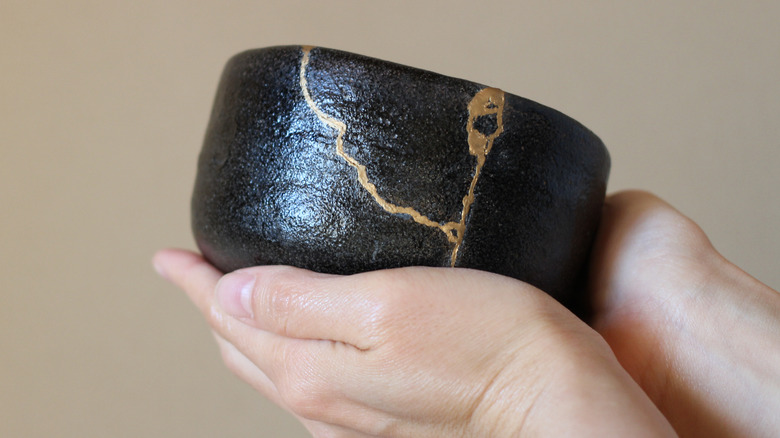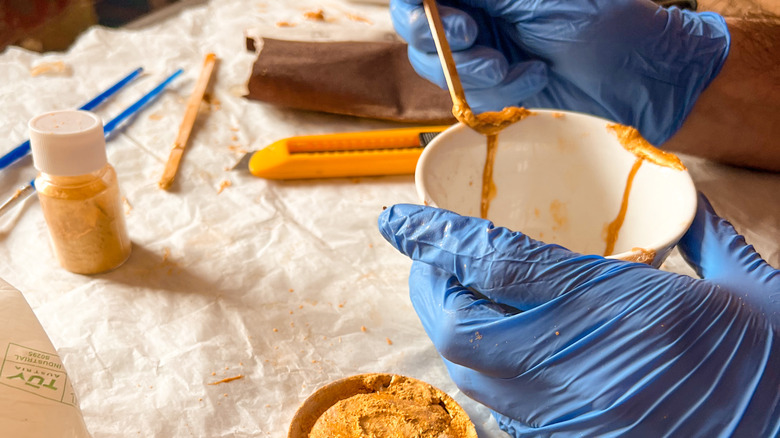The Art Of Kintsugi And How You Can Use It In Your Kitchen
We may receive a commission on purchases made from links.
In the heart of many homes, the kitchen is a testament to cherished moments and shared memories. Yet, it's also a place where wear and tear are most evident. When a favored dish shatters, it often evokes a pang of sadness. But what if there was a way to not only mend broken dishes but also elevate their beauty? The answer lies in Kintsugi (or Kintsukuroi), a centuries-old Japanese art form.
Originating from 15th-century Japan, Kintsugi, which translates to "golden joinery," is the delicate craft of restoring broken ceramics using lacquer combined with powdered gold, silver, or platinum. Unlike conventional repairs that seek to hide damages, Kintsugi celebrates every crack and fracture. It's a tangible embrace of the Wabi-sabi philosophy, which finds profound beauty in imperfection and views the natural wear of objects as a reflection of life's transient nature.
The application of Kintsugi in the kitchen offers a unique blend of aesthetics and functionality. Once considered a loss, a broken plate or chipped bowl can be reborn, its scars highlighted with gold, turning them into intricate narratives of history and resilience. Beyond mended pieces, the market has seen a surge in Kintsugi-inspired kitchenware, capturing the essence of this art in every intentional "flaw" etched into mugs, plates, and even in the design of Écriture, a two Michelin-starred restaurant in Hong Kong. Moreover, embracing this ethos in kitchen design can mean embracing the inherent flaws of natural materials, such as wooden kitchenware or handcrafted dishes, which, over time, bear the beautiful brunt of daily life.
How to create and use Kintsugi design
For those inspired to dabble in Kintsugi, it's an art form that requires patience and precision. If you think you have what it takes, here is a step-by-step guide on how to make your own Kintsugi art. Before we begin, prepare your space and gather all necessary materials. You will need a broken dish, epoxy adhesive (a non-toxic type is ArtResin), gold mica powder (or another non-toxic alternative), a mixing tray, and a brush.
Step one is to clean the broken ceramic pieces to ensure they are free from dust and oil. Next, create a golden adhesive by combining equal parts epoxy and mica powder. Quickly and delicately apply the mixture to the broken edges and join them to reform the object. Once the glue has cured, the piece will stand restored, its imperfections narrating a tale of recovery and elegance.
While gold remains the traditional medium, Kintsugi's philosophy is flexible, allowing for adaptations — alternatives like powdered silver, platinum, and copper add different hues and characteristics to the repair. The modern take involves mica powders (used in the example above), which, when mixed with adhesives, lend a metallic sheen reminiscent of the original technique. For those less adventurous, simply painting over a clear epoxy repair with non-toxic metallic paint captures the essence of the Kintsugi effect. However, a word of caution for culinary enthusiasts: Always ensure the materials are non-toxic and safe for food contact.
Kintsugi, more than just an art form
If Kintsugi interests you, don't stop here. Why wait until something breaks to practice it? Look for ceramic art or pottery, safely break it up into pieces, and begin experimenting. After all, there is more than one method of Kintsugi. There are three primary Kintsugi techniques, each offering a unique approach to restoration. First is the widely recognized crack method, where gold binds the broken pieces together. Next is the Makienaoshi method, wherein any missing fragments are replaced with gold substitutes crafted to fit. Finally, the joint approach combines pieces from a different item, integrating them into the broken artifact using gold as a seamless connector.
Don't limit yourself. You can use these different methods and techniques on more than just ceramicware or dishware. You can restore furniture this way, create a Kintusgi-inspired backsplash, repair serving ware or utensils, and even enhance light fixtures with the technique. To make this even more appealing to the beginner, DIY Kintsugi kits are available online, so you can jump right into applying this method around your home.
In wrapping up this exploration of Kintsugi, it becomes evident that it's more than just an art — it's a philosophy and a poignant reflection on life. It teaches resilience, the value of history, and the unparalleled beauty of imperfections. Whether through traditional techniques or modern interpretations, introducing Kintsugi into one's kitchen transforms every nick and crack into a proud testament of time, use, and the enduring spirit of beauty.

